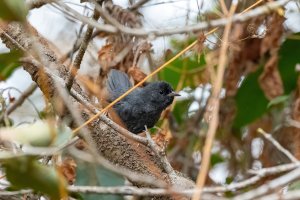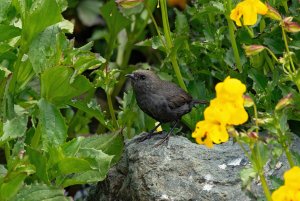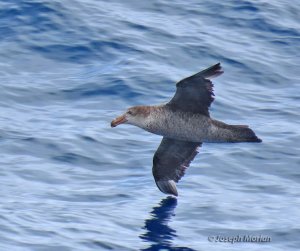-
Welcome to BirdForum, the internet's largest birding community with thousands of members from all over the world. The forums are dedicated to wild birds, birding, binoculars and equipment and all that goes with it.
Please register for an account to take part in the discussions in the forum, post your pictures in the gallery and more.
chile
-

Des Murs's Wiretail
A skulking little bird, very fond of bamboo thickets. This looks like a juvenile bird (not showing the adult's absurdly long tail), which is perhaps was more confiding.- Thibaud
- Media item
- chile sylviorthorhynchus desmursii valparaiso wiretail
- Comments: 5
- Category: Central & South America & Mexico
-

Dusky Tapaculo
The fourth tapaculo species of my central Chile trip, this one was in matorral, hopping about in the tangled branches of some oak-like trees- Thibaud
- Media item
- chile dusky tapaculo scytalopus fuscus tapaculo
- Comments: 5
- Category: Central & South America & Mexico
-

Magellanic Tapaculo
Of course, tapaculos that are found above the treeline are usually the easiest species to see, but this one was particularly bold, and I even saw it hopping on rocks just by a creek, like a miniature dipper!- Thibaud
- Media item
- chile scytalopus magellanicus tapaculo
- Comments: 8
- Category: Central & South America & Mexico
-

Northern Giant-Petrel
Greatly outnumbered by the similar Southern Giant-Petrel, Northern Giant-Petrel breeds no closer than South Georgia. Southern has a pale bill tip, while Northern has a dark reddish bill tip as seen here in this molting adult. However this distinction can be difficult to see in the field...- jmorlan
- Media item
- chile macronectes halli magellanes northern giant-petrel
- Comments: 3
- Category: Central & South America & Mexico
-

Chilean Skua
Sometimes called the Cinnamon Skua, this is the only Skua (not including the Jaegers) likely to be seen close to shore in Chilean waters. They are best identified by the variable cinnamon color on their throat and chest as seen here. The pale base to the bill is another helpful field mark...- jmorlan
- Media item
- chile chilean skua magellanes stercorarius chilensis
- Comments: 2
- Category: Central & South America & Mexico
-

White-tufted Grebe
One of two small species in the genus "Rollandia" endemic to South America, this breeding plumaged adult was part of a small flock. They are the most common grebes in Chile. They spend more time at the surface and less time diving than most other grebes. Of the three races, the nominate race is...- jmorlan
- Media item
- chile magellanes rollandia rolland white-tufted grebe
- Comments: 1
- Category: Central & South America & Mexico
-

Yellow-billed Pintail
Unlike the Northern Pintail, males of this species resemble the female year round. Three subspecies have been described, one of which is probably extinct, and the other of which is confined to South Georgia. This is the widespread "A. g. spinicauda" which averages larger, paler and longer-tailed...- jmorlan
- Media item
- anas georgica chile yellow-billed pintail
- Comments: 2
- Category: Central & South America & Mexico
-

Chilla (Lycalopex griseus)
There are two similar looking foxes found on the Patagonian Steppe. This is the smaller more common Chilla posing at the entrance to its den. It differs from the larger Culpeo (Lycalopex culpaeus) in having distinct dark patches on its hind legs, and longer more closely spaced ears. It is...- jmorlan
- Media item
- chile chilla lycalopex griseus
- Comments: 3
- Category: Wild Mammals
-

Crested Duck
The thin crest down the back of the head is hard to see and barely visible here. This unique South American endemic is the only member of the genus "Lophonetta." Genetic studies suggest an affinity with the Steamer-Ducks ("Tachyeres sp.") as well as Spectacled Duck ("Speculanas specularis") but...- jmorlan
- Media item
- chile crested duck lophonetta specularioides
- Comments: 1
- Category: Central & South America & Mexico
-

Common Miner
South American Miners build their nests by excavating tunnels in the earth. They are in the Furnariidae (Ovenbirds and Woodcreepers), not to be confused with Meliphagidae (Honeyeaters) of Australasia some of which are also called "Miners." The Common Miner has nine subspecies nominally arranged...- jmorlan
- Media item
- chile common miner geositta cunicularia
- Comments: 1
- Category: Central & South America & Mexico
-

Austral Negrito
Negritos are distinctive short-tailed tyrant flycatchers (Tyrannidae). They are among the least vocal of any "songbird" in that they have no song at all and only short alarm and contact notes. This is the Austral Negrito which is common in open country in southern South America. It is similar to...- jmorlan
- Media item
- austral negrito chile lessonia rufa
- Comments: 0
- Category: Central & South America & Mexico
-

Band-tailed Earthcreeper
The rusty band at the base of its tail gives this bird its name. This wren-like Furnarid was considered to be an Argentine endemic until one was collected in 1988 by Francois Vuilleumier in the Patagonian Steppe of extreme Eastern Chile. It is now known to breed there in small numbers. We...- jmorlan
- Media item
- band-tailed earthcreeper chile ochetorhynchus phoenicurus
- Comments: 5
- Category: Central & South America & Mexico
-

Crested Caracara
After being split from the northern Crested Caracara, this form ranging south of the Amazon basin has once again been lumped and becomes the nominate subspecies. Turns out they hybridize freely where they meet in Amazonia. Juveniles such as this differ from the northern race "C. p. cheriway" in...- jmorlan
- Media item
- caracara plancus chile crested caracara
- Comments: 6
- Category: Central & South America & Mexico
-

Correndera Pipit
Almost invisible against the background, these pipits were constantly on the move chasing each other. This one set down briefly allowing a quick photo. Widespread throughout southern South America, they are similar to North American Sprague's Pipits (Anthus spragueii) which are slightly smaller...- jmorlan
- Media item
- anthus correndera chile correndera pipit
- Comments: 2
- Category: Central & South America & Mexico
-
Magellanic Plover
Feeding behavior.- jmorlan
- Media item
- chile magellanic plover video
- Comments: 2
- Category: Central & South America & Mexico
-

Magellanic Plover
This species is neither a plover nor a sandpiper. It is actually a unique shorebird classified in its own family the Pluvianellidae. Genetic studies suggest it is closest to Sheathbills. It breeds locally inland in extreme southern Chile and Argentina and winters along the adjacent coast...- jmorlan
- Media item
- chile magellanic plover
- Comments: 3
- Category: Central & South America & Mexico
-

Lesser Rhea
This prehistoric looking flightless bird was originally included with Ostriches in Struthioniformes but now classified in its own order, the Rheiformes. Originally placed in its own genus "Pterocnemia" based on differences in tarsal feathering and number of tarsal scutes, it is now included in...- jmorlan
- Media item
- chile lesser rhea rhea pennatas
- Comments: 1
- Category: Central & South America & Mexico
-

Yellow-billed Teal
A small widespread duck found throughout the lowlands of Chile and Argentina. Yellow-billed is a split from the former "Speckled Teal" with dark billed birds in the north now treated as a separate species under the name Andean Teal. Yellow-billed Teal also has two distinctive subspecies. This is...- jmorlan
- Media item
- anas flavirostris chile yellow-billed teal
- Comments: 3
- Category: Central & South America & Mexico
-

Chilean Flamingo
Note the gray legs with bright pink intertarsal joints. Flamingos are said to have the longest legs of any birds in the world. They are filter feeders using fine lamellae on the inside of their bill to strain out small shrimp by pumping water out with their thick fleshy tongue. This species is...- jmorlan
- Media item
- chile chilean flamingo phoenicopterus chilensis
- Comments: 3
- Category: Central & South America & Mexico
-

Grass Wren
Usually shy and secretive except when singing. Grass Wren (not to be confused with the Grasswrens of Australia) has been split from the North American Sedge Wren replacing it in the neotropics. This one shows characters of "C. p. hornensis" or Austral Wren which ranges from Central Chile to...- jmorlan
- Media item
- chile cistothorus platensis grass wren
- Comments: 4
- Category: Central & South America & Mexico
-

Magellanic Snipe
Formerly considered to be a race of the Common Snipe (with Wilson's Snipe) and more recently treated as a race of South American Snipe (G. paraguaiae) but now split based on differences in display flight and sounds. Although Magellanic is usually paler and more buffy above, it is very difficult...- jmorlan
- Media item
- chile gallinago magellanica magellanic snipe
- Comments: 3
- Category: Central & South America & Mexico
-

Imperial Cormorant
Some authors (IOC, HBW, Birdlife International) use the English name "Imperial Shag." This is a non-breeding adult lacking a crest. Two types occur. Pacific birds (Blue-eyed Shags) have white cheeks and a blue orbital as seen here while some Atlantic and all Falkland birds (King Shags) have dark...- jmorlan
- Media item
- chile imperial cormorant phalacrocorax atriceps
- Comments: 3
- Category: Central & South America & Mexico
-
Rufous-collared Sparrow
Here is a video with sound of a singing bird Rufous-collared Sparrow.- jmorlan
- Media item
- chile rufous-collared sparrow video zonotrichia capensis
- Comments: 2
- Category: Central & South America & Mexico
-

White-crested Elaenia
Elaenias are rather cryptic small flycatchers of the American tropics. This species is highly migratory and there are vagrant records from South Padre Island, Texas and Grand Forks, North Dakota. Six subspecies are divided into three groups. This is a member of the "Chilean" group characterized...- jmorlan
- Media item
- chile elaenia albiceps white-crested elaenia
- Comments: 3
- Category: Central & South America & Mexico
-

Rufous-tailed Plantcutter
Here is an adult male apparently taking a dust bath. This photo shows the rufous tail band formed by reddish patches on the inner webs of the rectrices. Females are similar but streaked brown on their crown and chest. This species is endemic to Chile and adjacent Western Argentina. They use...- jmorlan
- Media item
- chile phytotoma rara rufous-tailed plantcutter
- Comments: 3
- Category: Central & South America & Mexico





